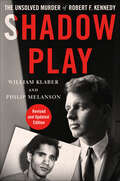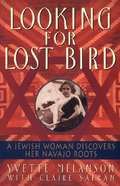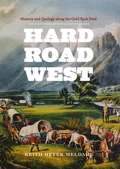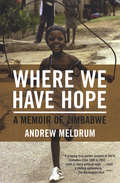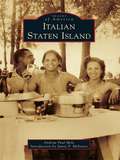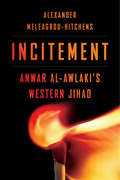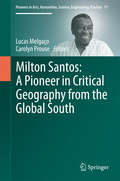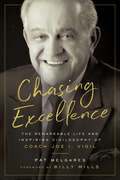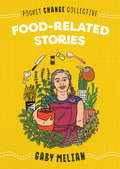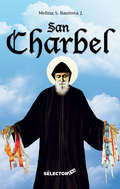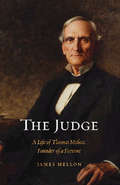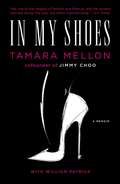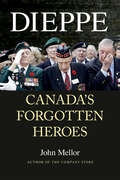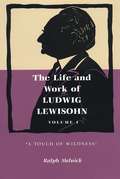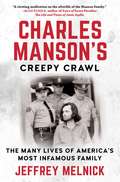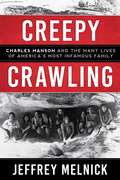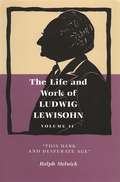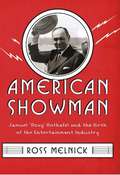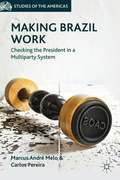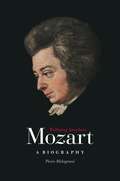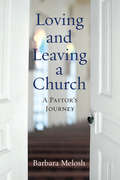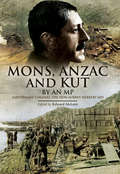- Table View
- List View
Shadow Play: The Unsolved Murder of Robert F. Kennedy
by Philip Melanson William KlaberThis updated edition for the 50th anniversary of Robert F. Kennedy’s murder explores ignored witness accounts, coerced testimony, bullet-hole evidence, and other issues surrounding the political homicide, and is the basis for the new podcast, The RFK Tapes, which debuted at #1 on the iTunes chart, available now.On June 4, 1968, just after he had declared victory in the California presidential primary, Robert F. Kennedy was gunned down in the kitchen of the Ambassador Hotel. Captured a few feet away, gun in hand, was a young Palestinian-American named Sirhan Sirhan. The case against Sirhan was declared “open and shut” and the court proceedings against him were billed as “the trial of the century”; American justice at its fairest and most sure. But was it? By careful examination of the police files, hidden for twenty years, William Klaber and Philip Melanson's Shadow Play explores the chilling significance of altered evidence, ignored witnesses, and coerced testimony. It challenges the official assumptions and conclusions about this most troubling, and perhaps still unsolved, political murder.
Looking for Lost Bird: A Jewish Woman Discovers Her Navajo Roots
by Yvette D. Melanson Claire SafranIn this haunting memoir, Yvette Melanson tells of being raised to believe that she was white and Jewish. At age forty-three, she learned that she was a "Lost Bird," a Navajo child taken against her family's wishes, and that her grieving birth mother had never stopped looking for her until the day she died... This is the story of her learning who she is.
Hard Road West: History and Geology along the Gold Rush Trail
by Keith Heyer MeldahlIn 1848 news of the discovery of gold in California triggered an enormous wave of emigration toward the Pacific. Lured by the promise of riches, thousands of settlers left behind the forests, rain, and fertile soil of the eastern United States in favor of the rough-hewn lands of the American West.
Where We Have Hope: A Memoir of Zimbabwe
by Andrew MeldrumWhere We Have Hope is the gripping memoir of a young American journalist. In 1980, Andrew Meldrum arrived in a Zimbabwe flush with new independence, and he fell in love with the country and its optimism. But over the twenty years he lived there, Meldrum watched as President Robert Mugabe consolidated power and the government evolved into despotism. In May 2003, Meldrum, the last foreign journalist still working in the dangerous and chaotic nation, was illegally forced to leave his adopted home. His unflinching work describes the terror and intimidation Mugabe’s government exercised on both the press and citizens, and the resiliency of Zimbabweans determined to overturn Mugabe and demand the free society they were promised.
Italian Staten Island (Images of America)
by Andrew Paul Mele James P. MolinaroThe great wave of European immigration in the late 19th and early 20th centuries brought more than four million Italians to America. It was one of the greatest mass emigrations in world history, and many settled in Staten Island. Following the opening of the Verrazano-Narrows Bridge in 1964, the island experienced another great influx of Italian immigrants, this time from the other boroughs of New York City. This new wave was responsible for doubling the island population by the year 2000. Italian Americans are evident in every avocation and in each corner of Staten Island society, with achievers in education, business, government, medicine, and sports and entertainment. Italian Staten Island chronicles the traditions, culture, and heritage of Italian Americans through more than 200 photographs.
Incitement: Anwar al-Awlaki’s Western Jihad
by Alexander Meleagrou-HitchensThe definitive account of the career and legacy of the most influential Western exponent of violent jihad. Anwar al-Awlaki was, according to one of his followers, “the main man who translated jihad into English.” By the time he was killed by an American drone strike in 2011, he had become a spiritual leader for thousands of extremists, especially in the United States and Britain, where he aimed to make violent Islamism “as American as apple pie and as British as afternoon tea.” Alexander Meleagrou-Hitchens draws on extensive research among al-Awlaki’s former colleagues, friends, and followers, including interviews with convicted terrorists, to explain how he established his network and why his message resonated with disaffected Muslims in the West. A native of New Mexico, al-Awlaki rose to prominence in 2001 as the imam of a Virginia mosque attended by three of the 9/11 hijackers. After leaving for Britain in 2002, he began delivering popular lectures and sermons that were increasingly radical and anti-Western. In 2004 he moved to Yemen, where he eventually joined al-Qaeda and oversaw numerous major international terrorist plots. Through live video broadcasts to Western mosques and universities, YouTube, magazines, and other media, he soon became the world’s foremost English-speaking recruiter for violent Islamism. One measure of his success is that he has been linked to about a quarter of Islamists convicted of terrorism-related offenses in the United States since 2007. Despite the extreme nature of these activities, Meleagrou-Hitchens argues that al-Awlaki’s strategy and tactics are best understood through traditional social-movement theory. With clarity and verve, he shows how violent fundamentalists are born.
A Gift of Hope: The Tony Melendez Story
by Tony Melendez Mel WhiteFrom the Publisher: The inspiring story of a young thalidomide victim and talented musician who has gained international recognition. Wonderful reading for anyone--especially those facing seemingly insurmountable difficulties. ... This is a beautifully, and positively, written autobiography. Melendez neither downplays his and his family's struggles resulting from his lack of arms, nor does he whine about them. Writing about his father, "Still, he knew that only in America would he find the kind of medical treatment I needed, so he put his own dreams aside and began to dream for me. He was young, strong, and determined to provide for each of us-but especially, I believe, for me. Imagine his growing frustration as he tried to support us on the minimum wage jobs that he could find. And there was no extra time or money to train in another field. [In Nicaragua, he was educated and accomplished in the fields of agriculture and animal husbandry.] Instead, he found himself in a huge pool of cheap labor as more and more unskilled young people migrated to America."
Milton Santos: A Pioneer in Critical Geography from the Global South
by Lucas Melgaço Carolyn ProuseFor decades, Milton Santos (1926-2001) has been considered one of the most influential thinkers in Brazilian and Latin American social sciences and geography. Yet his writings, most of which have not been translated into English, are largely unknown to European and North American audiences. This book introduces English-speaking scholars to Professor Santos through critical engagement with his ideas and writings. The chapters presented here reveal the breadth and originality of his critical thought, as well as its ongoing importance to contemporary debates. The book features a biography of Santos and includes an annotated translation of one of his most-cited texts, The Return of the Territory, offered here for the first time in English. This text demonstrates how Santos's provocative insights continue to transform core concepts of political and human geography. The book also includes a number of short chapters written by scholars from Brazil, Spain and France. Through reflections on Santos's work, the various authors demonstrate the value and possibilities of extending the geographer's theories. They explore key geographical themes across political economy, rural studies, territorial planning, environmental crisis, digital networks, indigenous peoples, transportation and public health. This collection invites geographers from around the world to engage with this rich intellectual tradition from Brazil.
Chasing Excellence: The Remarkable Life and Inspiring Vigilosophy of Coach Joe I. Vigil
by Pat Joseph MelgaresWinner, Best Sports Book, International Latino Book Awards; Best Biography, Independent Book Publishers Association Dr. Joe I. Vigil—known simply as "Coach" to virtually everybody he has ever met—rose from poverty to become a towering figure in the running world. Coach has won 19 national championships and coached 425 All-Americans, 22 Olympians...and an army of "Vigilantes" who seek to emulate his unique blend of compassion, competitive spirit, and commitment to others. In this long-overdue biography about America's preeminent distance-running coach, author and Vigilante Pat Melgares shares Coach Vigil's tale not just through the consummate storyteller's own words but also through those of more than 50 family members, friends, former runners, and foes who have been shaped by his presence over a lifetime. Coach Vigil is driven by a persistent desire to learn, a deep faith in people, and an unwavering loyalty to his hometown of Alamosa, Colorado. His life is an American dream—a must-read for anyone who loves an underdog or seeks to understand the timeless qualities that forge a leader. "Chasing Excellence" has been Coach Vigil's mantra for decades, for himself and those he teaches. Now in his 90s, he's as relentless as ever in that quest. "If you are a teacher, a coach, an administrator . . . or anyone in a leadership role . . . read this book! If you are an athlete or anyone in pursuit of achieving excellence in your field . . . read this book! – Ryun G., verified purchaser
Food-Related Stories (Pocket Change Collective)
by Gaby Melian&“Gaby Melian tells so many stories through her relationship with food—about love, about loss, about hard work, and about finding her passion. The pages are dripping with delicious smells and tastes, and will give you a new way to look at both cooking and what it means to have a plan.&” —Molly Birnbaum, editor in chief, America&’s Test Kitchen KidsIn this moving, personal account, chef and activist Gaby Melian shares her journey with food and how creating a relationship with food -- however simple or complicated -- is a form of activism in its own right.Pocket Change Collective was born out of a need for space. Space to think. Space to connect. Space to be yourself. And this is your invitation to join us. This is a series of small books with big ideas from today's leading activists and artists. "Food rescued me so many other times -- not only because I sold food to survive. I cook to entertain; I cook to be liked; I cook to be loved." In this installment, chef and activist Gaby Melian shares her personal journey with food -- from growing up in Argentina to her time as a Jersey City street vendor and later, as Bon Appetit's test kitchen manager. Powerful and full of heart, here, Melian explores how we can develop a relationship with food that's healthy, sustainable, and thoughtful.
San Charbel
by Melina S. Bautista J.En este novedoso libro, Melina nos presenta la vida de San Charbel, sus milagros, devociones, sacramentales, crónicas de sus celebraciones y de experiencias de sus seguidores, que inflaman el corazón de los creyentes. Todo lo que los devotos del santo libanés desearían saber para aumentar su conocimiento y devoción, lo encontrarán en este volumen. Tienes en tus manos una obra que, sin duda, será un instrumento que te ayudará a orar y enriquecer tu vida cristiana.
The Judge: A Life of Thomas Mellon, Founder of a Fortune
by James MellonLawyer, judge, banker, classics professor, and councilman, Thomas Mellon greatly influenced the fortunes of his hometown, Pittsburgh, throughout the nineteenth century. In the process, he became one of the city's most important business leaders, and he laid the foundation for a family that would contribute considerably to the city's growth and welfare for much of the next hundred years, becoming one of the world's most recognizable names in industry, innovation, and philanthropy. Through his in-depth examination of the extensive Mellon family archives, in The Judge James Mellon--a direct descendent of Thomas Mellon--has fashioned an incisive portrait of the elder Mellon that presents the man in full. Offering a singular and insightful characterization of the Scotch-Irish value system that governed the patriarch's work and life, James Mellon captures the judge's complexities and contradictions, revealing him as a truly human figure. Among the recent biographies of Pittsburgh's famous businessmen, The Judge stands apart from the pack because of the author's unique perspective and his objective and scholarly approach to his subject.
In My Shoes: A Memoir
by Tamara Mellon William PatrickA juicy true story about sex, drugs, money, power, high heels, and overcoming adversity. Tamara Mellon used her business savvy, creative eye, and flair for design to build Jimmy Choo into a premier name in global fashion. But despite her eventual fame and fortune, Mellon didn't have an easy road to success. Her seemingly glamorous beginnings were marked by a tumultuous family life, battles with anxiety and depression, and a stint in rehab. Now Mellon shares the whole larger-thanlife story--from her time as a young editor at Vogue to her partnership with cobbler Jimmy Choo to her very public relationships. In creating the shoes that became a fixture on Sex and the City and red carpets around the world, Mellon relied on her own impeccable sense of what her customers wanted. What she didn't know at the time was that success would come at a high price: struggles with an obstinate business partner, a conniving first CEO, a turbulent marriage, and a mother who tried to steal her hard-earned wealth.
Dieppe: Canada's Forgotten Heroes
by John MellorThis WWII historical memoir chronicles the Canadian-led raid on a Nazi-occupied port in Northern France, as well as capture and escape from POW camps. Gripping in its intensity and detail, John Mellor&’s account of the doomed raid on Dieppe, France, in 1942 combines authoritative research with his own firsthand experience. Examining the debate surrounding this tactical failure, Mellor also puts the reader in the landing craft and on the beaches with individual Canadian soldiers. Dieppe recounts the terrible deaths of 807 Canadians and the damage to 1,946 survivors whose subsequent march to German prisoner-of-war camps is nearly as tragic as the raid itself. Mellor writes candidly about the survival tactics, the successful tunnel escapes, and the heroism of nearly three years in appalling captivity, including the desperate &“death marches&” the prisoners endured.
Charmed Circle: Gertrude Stein and Company
by James R. MellowThe iinfluence of Stein and her literary circle on the literature of Europe and America.
The Life and Work of Ludwig Lewisohn: Volume 1: "A Touch of Wildness"
by Dr Ralph MelnickAn imposing literary figure in America and Europe during the first half of the twentieth century, Ludwig Lewisohn (1882-1955) struggled with feelings of alienation in Christian America that were gradually resolved by his developing Jewish identity, a process reflected in hundreds of works of fiction, literary analysis, and social criticism. <P><P> A friend and associate of Sinclair Lewis, James Joyce, Thomas Mann, Paul Robeson, Edward G. Robinson, Theodore Dreiser, H. L. Mencken, Stephen Wise, Maurice Samuel, and a host of others, Lewisohn impacted the intellectual, cultural, religious, and political worlds of two continents. <P><P> This first volume, chronicling his life until 1934, is followed by a second volume that portrays Lewisohn's last decades as an outspoken opponent of Nazi Germany, a leading promoter of Jewish rescue and resettlement in Palestine, a member of Brandeis University's first faculty, and one of the earliest voices advocating Jewish renewal in America. <P><P> Born in Berlin, Lewisohn moved with his family in 1890 to South Carolina. Identified by others as a Jew, he remained an outsider throughout his youth. As a graduate student at Columbia University, warnings that a Jew could not secure a position teaching English forced him to abandon his studies. The Broken Snare (1908), Lewisohn's story of a young woman's acceptance of her deepest thoughts and desires, paralleled his own reaction to this isolation. Attacking the social mores of his age, the novel was judged as scandalous by critics. <P><P> In time Lewisohn became a notable scholar and translator of German and French literature, teaching at Wisconsin and Ohio State. Following his mother's death in 1914, he began to explore the Jewish life he had rejected, and by 1920 became a Zionist committed to fighting assimilation. Accusatory and inflammatory, his memoir Up Stream (1922) struck at the very heart of American culture and society, and caused great controversy and lasting enmity. <P><P> As strong emotional influences, the women in Lewisohn's life-his mother and four wives-helped to frame his life and work. Believing himself liberated by the woman he declared his "spiritual wife" while legally married to another, he proclaimed the artist's right to freedom in The Creative Life (1924), abandoned his editorship at The Nation, and fled to Europe. Lewisohn's fictionalized account of his failed marriage, The Case of Mr. Crump (1926), once again attacked the empty morality of this world and won Sigmund Freud's praise as the greatest psychological novel of the century. <P><P> A creator of one of Paris's leading salons, Lewisohn ended his leisurely writer's life in 1934 to awaken America to the growing Nazi threat. Poised to face the unfinished marital battle at home, but anxious to engage in the coming struggle for Jewish survival and the future of Western civilization, he set sail, unsure of what lay ahead.
Charles Manson's Creepy Crawl: The Many Lives of America's Most Infamous Family
by Jeffrey MelnickWith a new epilogue updated from its hardcover edition titled Creepy Crawling: Charles Manson and the Many Lives of America's Most Infamous Family "Creepy crawling" was the Manson Family's practice of secretly entering someone's home, and without harming anyone, leaving only a trace of evidence that they had been there, some reminder that the sanctity of the private home had been breached. Now, author Jeffrey Melnick reveals just how much the Family creepy crawled their way through Los Angeles in the sixties and then on through American social, political, and cultural life for fifty years, firmly lodging themselves in our minds. Even now, it is almost impossible to discuss the sixties, teenage runaways, sexuality, drugs, music, California, or even the concept of family without referencing Manson and his "girls." Not just another Charles Manson history, Charles Manson's Creepy Crawl: The Many Lives of America's Most Infamous Family explores how the Family weren't so much outsiders as emblematic of the Los Angeles counterculture freak scene, and how Manson worked to connect himself to the mainstream of the time. Ever since they spent two nights killing seven residents of Los Angeles—what we now know as the "Tate-LaBianca murders"—the Manson family has rarely slipped from the American radar for long. From Emma Cline's The Girls to the TV show Aquarius, as well as two major films in 2019, including Quentin Tarantino's Once Upon a Time in Hollywood, the family continues to find an audience. What is it about Charles Manson and his family that captivates us still? Author Jeffrey Melnick sets out to answer this question in this fascinating and compulsively readable cultural history of the Family and their influence from 1969 to the present.
Creepy Crawling: Charles Manson and the Many Lives of America's Most Infamous Family
by Jeffrey Melnick"Creepy crawling" was the Manson Family's practice of secretly entering someone's home and, without harming anyone, leaving only a trace of evidence that they had been there, some reminder that the sanctity of the private home had been breached. Now, author Jeffrey Melnick reveals just how much the Family creepy crawled their way through Los Angeles in the sixties and then on through American social, political, and cultural life for close to fifty years, firmly lodging themselves in our minds. Even now, it is almost impossible to discuss the sixties, teenage runaways, sexuality, drugs, music, California, and even the concept of family without referencing Manson and his "girls." Not just another history of Charles Manson, Creepy Crawling explores how the Family weren't so much outsiders but emblematic of the Los Angeles counterculture freak scene, and how Manson worked to connect himself to the mainstream of the time. Ever since they spent two nights killing seven residents of Los Angeles-what we now know as the "Tate-LaBianca murders"-the Manson family has rarely slipped from the American radar for long. From Emma Cline's The Girls to the recent TV show Aquarius, the family continues to find an audience. What is it about Charles Manson and his family that captivates us still? Author Jeffrey Melnick sets out to answer this question in this fascinating and compulsively readable cultural history of the Family and their influence from 1969 to the present.
Life and Work of Ludwig Lewisohn, Volume II: "This Dark and Desperate Age"
by Ralph MelnickThis second volume portrays Lewisohn's last decades as an outspoken opponent of Nazi Germany, a leading promoter of Jewish resettlement in Palestine, a member of Brandeis University's first faculty, and one of the earliest voices advocating Jewish renewal in America. Despite his activism, Lewisohn was no longer welcome in Zionist circles by 1948 as a result of his "unacceptable" opinions concerning British intransigence, organizational politics, and, particularly, Jewish cultural and religious decline. However, the invitation to join the newly established Brandeis University as its only full professor provided him with the opportunity he sought to contribute to the reshaping of American Jewry. Lewisohn's efforts would later bear fruit in the Jewish renewal movement of the next generation.
American Showman: Samuel "Roxy" Rothafel and the Birth of the Entertainment Industry, 1908–1935 (Film and Culture Series)
by Ross MelnickSamuel "Roxy" Rothafel (1882–1936) built an influential and prolific career as film exhibitor, stage producer, radio broadcaster, musical arranger, theater manager, war propagandist, and international celebrity. He helped engineer the integration of film, music, and live performance in silent film exhibition; scored early Fox Movietone films such as Sunrise (1927); pioneered the convergence of film, broadcasting, and music publishing and recording in the 1920s; and helped movies and moviegoing become the dominant form of mass entertainment between the world wars. <P><P>The first book devoted to Rothafel's multifaceted career, American Showman examines his role as the key purveyor of a new film exhibition aesthetic that appropriated legitimate theater, opera, ballet, and classical music to attract multi-class audiences. Roxy scored motion pictures, produced enormous stage shows, managed many of New York's most important movie houses, directed and/or edited propaganda films for the American war effort, produced short and feature-length films, exhibited foreign, documentary, independent, and avant-garde motion pictures, and expanded the conception of mainstream, commercial cinema. He was also one of the chief creators of the radio variety program, pioneering radio broadcasting, promotions, and tours.The producers and promoters of distinct themes and styles, showmen like Roxy profoundly remade the moviegoing experience, turning the deluxe motion picture theater into a venue for exhibiting and producing live and recorded entertainment. Roxy's interest in media convergence also reflects a larger moment in which the entertainment industry began to create brands and franchises, exploit them through content release "events," and give rise to feature films, soundtracks, broadcasts, live performances, and related consumer products. Regularly cited as one of the twelve most important figures in the film and radio industries, Roxy was instrumental to the development of film exhibition and commercial broadcasting, musical accompaniment, and a new, convergent entertainment industry.
Making Brazil Work
by Marcus André Melo Carlos PereiraThis book offers the first conceptually rigorous analysis of the political and institutional underpinnings of Brazil's recent rise. Using Brazil as a case study in multiparty presidentialism, the authors argue that Brazil's success stems from the combination of a constitutionally strong president and a robust system of checks and balances.
Wolfgang Amadeus Mozart: A Biography
by Piero Melograni Lydia G. CochraneAn engaging account of one of the most enduringly popular and celebrated composers to have ever lived, this book is both readable and scholarly, and grounded by a wealth of Mozart's correspondence. His substantial oeuvre contains works that are considered to be among the most exquisite pieces of symphonic, chamber, and choral music ever written. His operas too cast a long shadow over those staged in their wake. And since his untimely death in 1791, he remains an enigmatic figure -- the subject of fascination for aficionados and novices alike. Piero Melograni here offers a wholly readable account of Mozart's remarkable life and times. This masterful biography proceeds from the young Mozart's earliest years as a wunderkind -- the child prodigy who traveled with his family to perform concerts throughout Europe -- to his formative years in Vienna, where he fully absorbed the artistic and intellectual spirit of the Enlightenment, to his deathbed, his unfinished Requiem, and the mystery that still surrounds his burial. Melograni's deft use of Mozart's letters throughout confers authority and vitality to his recounting, and his expertise brings Mozart's eighteenth-century milieu evocatively to life. Written with a gifted historian's flair for narrative and unencumbered by specialized analyses of Mozart's music, Melograni's is the most vivid and enjoyable biography available. At a time when music lovers around the world are paying honor to Mozart and his legacy,Wolfgang Amadeus Mozart will be welcomed by his enthusiasts -- or anyone wishing to peer into the mind of one of the greatest composers ever known.
Loving and Leaving a Church: A Pastor's Journey
by Barbara MeloshBarbara Melosh's story was a common one. A second-career seminarian, she arrived at her first pastorate brimming with enthusiasm and high hopes. The blue-collar congregation to which she'd been called had a glorious past but an uncertain future. Certain that she could turn around its slow yet undeniable slide into decline, Melosh inaugurated a number of church growth and outreach programs. Most of these efforts had little effect, and the ones that did seem to work soon suffered reverse outcomes and eventual demise. In the end, Melosh had to conclude that the members of the congregation liked their church the way it was and that she could not drag them into a future they did not want. <P><P> Yet while the congregation failed to change itself, Melosh notes, it succeeded in changing her. Simply put, it made her a pastor. At times heartbreaking and hilarious, Loving and Leaving a Church offers a glimpse into the challenges and opportunities of ministry in a mainline church.
Mons, Anzac and Kut: By an MP (Lieutenant Colonel The Hon Aubrey Herbert MP)
by Edward MelotteAubrey Herbert was one of the most interesting figures of his age. He was twice offered the Albanian throne! Born almost blind, his sight even after surgery precluded him from official military service and he became a diplomat and politician. However in 1914 he attached himself unofficially to the Irish Guards on the outbreak of war on their way to France and was made an honorary Lieutenant. Despite his service overseas in France, the Dardanelles and then Egypt and Iraq, he remained an MP throughout the War. He was briefly captured in the Retreat from Mons and, after recovering from his wounds, he joined the Intelligence Bureau in Egypt before being attached to the New Zealand and Australian Division at Gallipoli. He personally persuaded General Ian Hamilton, the overall Commander, to agree a temporary truce with the Turks to enable the burial of the dead and the recovery of wounded men in no-mans-land. Later in Iraq, his efforts to buy the release of the beleaguered British garrison at Kut were less successful. His extraordinary war experiences brought him into close contact with a wide cast of characters, not least T E Lawrence, Compton McKenzie and leading military and political figures.
